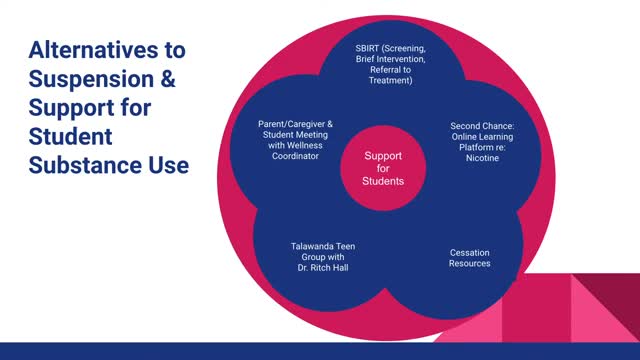Students Thrive as Substance Use Programs Show Success
June 21, 2024 | Talawanda City, School Districts, Ohio

This article was created by AI summarizing key points discussed. AI makes mistakes, so for full details and context, please refer to the video of the full meeting. Please report any errors so we can fix them. Report an error »

In a recent government meeting, officials highlighted the success of various initiatives aimed at reducing substance use and promoting mental health among students in the Tallawanda School District. The discussions centered around the effectiveness of educational programs and community partnerships that have led to significant positive outcomes.
One of the key points shared was the success of the \"2nd Chance\" online platform, which reported that 76% of students engaged in the curriculum were less likely to quit using substances. Notably, there was an 88% decrease in the number of cartridges used daily among participants, showcasing a clear trend towards harm reduction. High school students expressed that the program served as a critical wake-up call, with two students seeking help after recognizing their substance use issues.
The meeting also revealed that Tallawanda Middle School reported no second infractions for substance use violations this year, while 92% of high school students did not face repeat infractions. This success was attributed to alternative programming and strong leadership within the school administration. The district calculated that students who would have previously faced expulsion earned a total of 120 credits while maintaining a high passing rate in their classes.
A survey conducted among 738 students in grades 7 through 12 indicated a downward trend in substance use, aligning closely with regional data. The survey results showed that only 5.3% of students reported using e-cigarettes, a significant reduction from previous years. The district emphasized the importance of reframing social norms around substance use, particularly among younger students.
Mental health concerns were also addressed, with data indicating that a third of students reported feeling anxious or nervous frequently. The district is committed to improving mental health support, with initiatives aimed at fostering relationships between students and caring adults in schools.
The meeting concluded with a focus on future initiatives, including the expansion of outreach programs and the introduction of telehealth services in rural areas to improve access to mental health resources. The collaborative efforts of various community organizations, including the HOPE Cooperative, were praised for their role in addressing these critical issues.
Overall, the meeting underscored the importance of community cooperation and proactive measures in fostering a healthier environment for students, with a commitment to ongoing support and education in the face of substance use and mental health challenges.
One of the key points shared was the success of the \"2nd Chance\" online platform, which reported that 76% of students engaged in the curriculum were less likely to quit using substances. Notably, there was an 88% decrease in the number of cartridges used daily among participants, showcasing a clear trend towards harm reduction. High school students expressed that the program served as a critical wake-up call, with two students seeking help after recognizing their substance use issues.
The meeting also revealed that Tallawanda Middle School reported no second infractions for substance use violations this year, while 92% of high school students did not face repeat infractions. This success was attributed to alternative programming and strong leadership within the school administration. The district calculated that students who would have previously faced expulsion earned a total of 120 credits while maintaining a high passing rate in their classes.
A survey conducted among 738 students in grades 7 through 12 indicated a downward trend in substance use, aligning closely with regional data. The survey results showed that only 5.3% of students reported using e-cigarettes, a significant reduction from previous years. The district emphasized the importance of reframing social norms around substance use, particularly among younger students.
Mental health concerns were also addressed, with data indicating that a third of students reported feeling anxious or nervous frequently. The district is committed to improving mental health support, with initiatives aimed at fostering relationships between students and caring adults in schools.
The meeting concluded with a focus on future initiatives, including the expansion of outreach programs and the introduction of telehealth services in rural areas to improve access to mental health resources. The collaborative efforts of various community organizations, including the HOPE Cooperative, were praised for their role in addressing these critical issues.
Overall, the meeting underscored the importance of community cooperation and proactive measures in fostering a healthier environment for students, with a commitment to ongoing support and education in the face of substance use and mental health challenges.
View full meeting
This article is based on a recent meeting—watch the full video and explore the complete transcript for deeper insights into the discussion.
View full meeting
